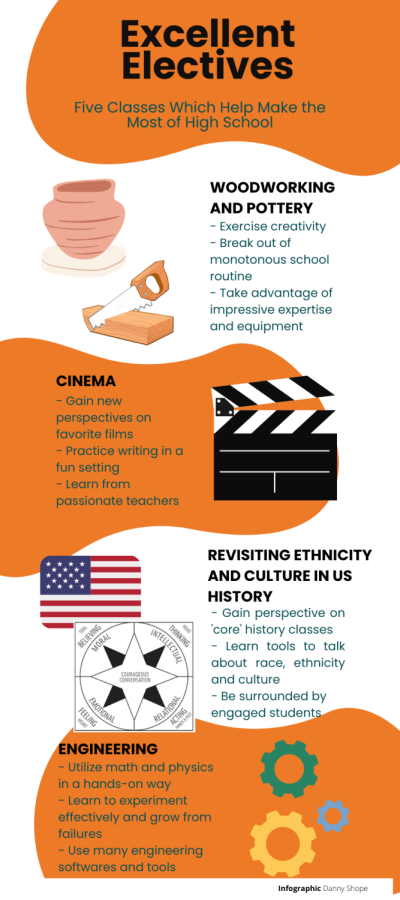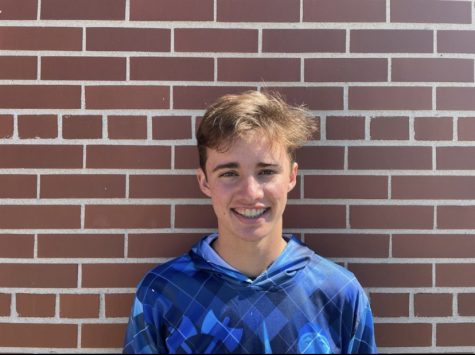Looking back on five excellent electives
Classes that made an impact
May 11, 2022
It felt like a breath of fresh air when I graduated middle school four years ago and moved onto high school. That’s because this transition comes with a lot of new freedoms, and the one I was most excited about was being able to choose many more elective courses.
With these options, students have the chance to explore burning passions, try new things, or examine thought-provoking perspectives they wouldn’t be able to in their main classes. Park has an impressive selection of electives, and every class I’ve taken here has had a lot of value. Here are a few elective classes that were especially interesting or impactful for me.
Woodworking and Pottery
I’ll admit it — I did not take pottery or woodworking by choice. I took them in an effort to avoid doing any painting or drawing while still fulfilling the art credit requirement for graduation, but I ended up being very glad I did.
Even with the most interesting academic classes, sitting at a desk and listening to lectures just gets old after a while. Pottery and woodworking were completely different — they were mostly unstructured and hands-on and they involved a lot of moving around.
The teachers for these classes know their stuff, and they’re up for answering basically any question you could have — but they also know when to step back and let students experiment to find out what works and what doesn’t.
For me, the best part of these classes was that they were a way to exercise creativity in a low-risk way and learn skills that are extremely applicable outside of class. At the end of the semester, even though I was not particularly talented in either class, it was rewarding to be able to take home all the projects I’d worked on.
I don’t think many students are aware of the impressive equipment and expertise we have available through these classes, but more students should take advantage of them.
Cinema
“All you have to do is watch movies. At school. Need I say more?” This is what a friend said to convince me to take cinema. Interestingly, though, it ended up being mostly untrue.
First of all, with the pandemic, I wasn’t watching movies at school. Second, we didn’t just watch films — there was plenty of discussing, analyzing and writing to go along with them. But honestly, both of these made the class even more worthwhile.
During remote learning, school took a lot of effort. For me, cinema was that one class I almost always looked forward to doing the homework for. That’s partially because a lot of the homework was just sitting on the couch and watching movies — a much-needed break from the insanity of the rest of the world.
On top of that, though, I found myself really interested in the analysis of the films. The class was formatted almost like a book club, where we watched the films, took notes, and wrote about them outside of class. In class, we just talked about what we found interesting. Discussing movies with classmates and the teacher made them even more fun to watch.
Cinema ended up being more time-consuming than I thought it would be, but I also got a lot more out of it. My writing improved, and I found a new interest. Also, whenever I’m watching movies or TV now, it’s hard not to constantly see the film techniques we talked about in class (which is a blessing and a curse, but mostly a blessing).
Engineering
Being a complete math nerd made engineering amazing.
Funny enough, even though engineering is a STEM subject, it felt very similar to the art classes I’d taken. It was unstructured, and there was a lot of creativity to it. Most of the time, students got to explore the engineering process through trial and error with the impressive equipment the school had to offer.
Being able to use math and science in a completely new way made me even more interested in pursuing those subjects further. And similarly to pottery and woodworking, engineering was a way to mix up the normal school routine.
Revisiting Ethnicity and Culture in US History
I think every student who takes a US history course should also take this class. In many history classes, especially AP or IB courses, teachers have to scramble to cover as many surface-level facts as possible. Revisiting Ethnicity and Culture, on the other hand, was not tied to a strict curriculum. This left much more freedom to cover what the teacher and students thought was most important.
The title for this class describes it pretty well. It revisited topics that were missed in other US history classes offered by the school, often through the lens of race and ethnicity. It led me to reflect a lot on what I had learned in the past, and it gave me tools to continue to look at the world from different perspectives.
For me, the in-class discussion was equally as valuable as the information from the lectures. The teacher was extremely knowledgeable (in fact, she put together the textbook for the class), and the students were engaged and interested.
Revisiting Ethnicity and Culture was not an easy class. There weren’t any tests or essays, but it required a lot of focus. On top of that, it dives deeper into some parts of US history and reveals some dark truths which can be uncomfortable to come to terms with. Fortunately, diving deeper also revealed many inspiring aspects of history which give me hope for the future.




